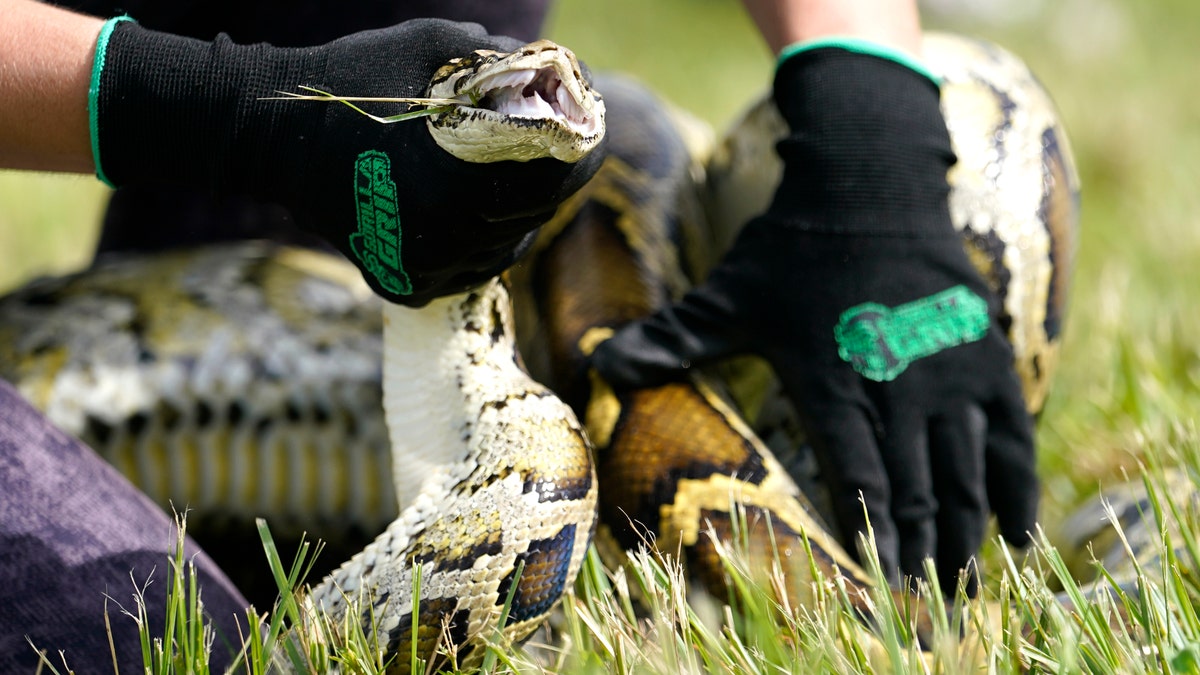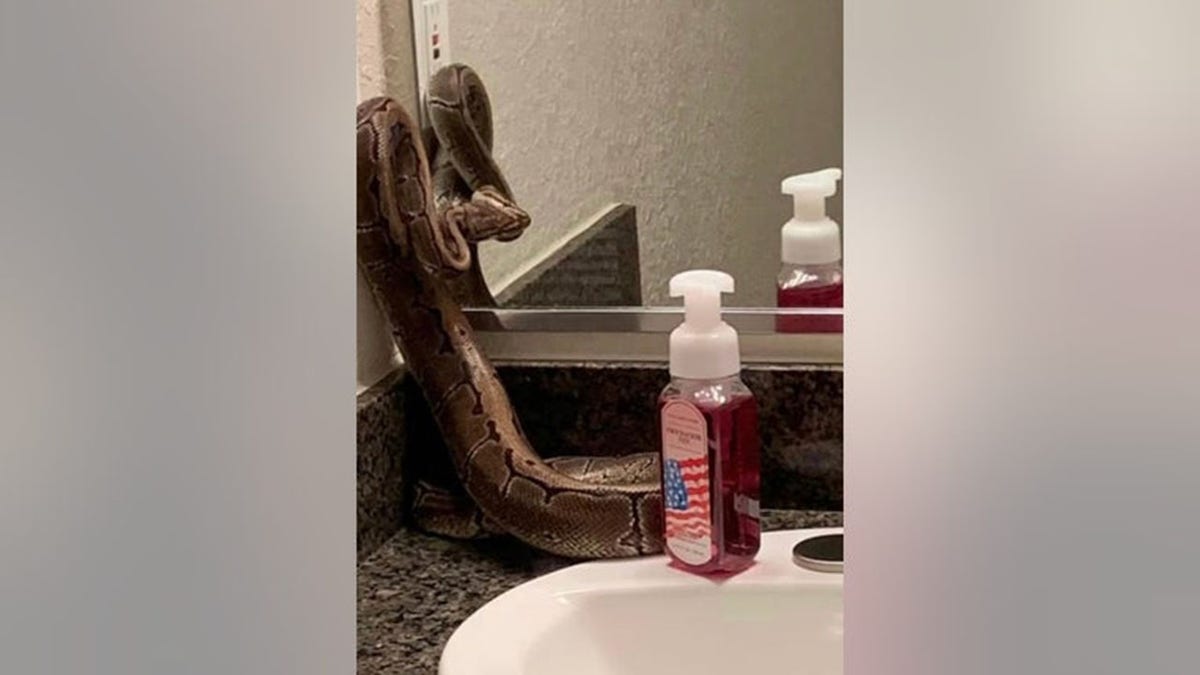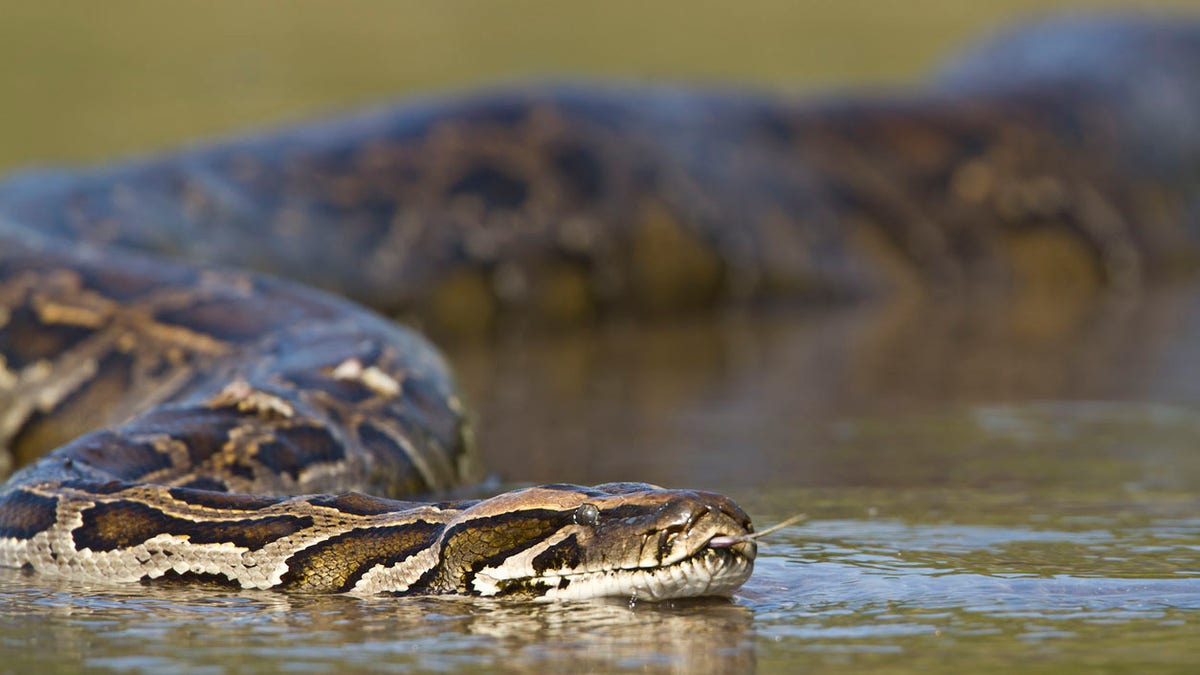Massive Burmese python slithers across road in Florida Everglades
Wildlife photographers spotted a giant Burmese python in Florida's Everglades National Park on Monday. (Credit: Kymberly Clark via Storyful)
South Florida researchers are working on a new way to track and capture invasive Burmese pythons by using small mammals outfitted with GPS devices, according to reports.
The Tampa Bay Times reported that a group of researchers has been watching raccoon and possum behavior on the edges of Crocodile National Wildlife Refuge, located nearly 40 miles south of Miami in Key Largo.

FILE - A Burmese python is held during a safe capture demonstration on June 16, 2022, in Miami. More than 800 competitors will be trudging through the Florida Everglades for the next eight days, in search of invasive Burmese pythons that will bring in thousands of dollars in prize money. The python hunt officially began Friday, Aug. 5, and runs through Aug. 15. Officials who gathered in Miami to kick off the annual campaign say it's significant because the non-native snakes are killing off birds and mammals in the Everglades ecosystem. (AP Photo/Lynne Sladky, File)
The small animals that the researchers have been observing all have GPS collars, allowing the team to track the locations of the possums and raccoons.
FLORIDA MAN CAPTURES 28 BURMESE PYTHONS TO WIN TOP PRIZE IN STATE'S ANNUAL CHALLENGE
After about five months, the researchers had a bit of a breakthrough when one possum collar used in the field suddenly stopped moving for a few hours then began once again.
The lack of movement triggered what researchers called a mortality signal, but when it started moving again, the researchers had a hunch the small mammal may have been eaten by a snake, Michael Cove, the curator of mammals at the North Carolina Museum of Natural Sciences told the Tampa Bay Times.
Cove is working on the project with members of the U.S. Fish and Wildlife Service and Southern Illinois University.

Ali Skipper Orlando Python apartment (Ali Skipper)
The thought was that a python had remained in the area as it digested the possum before moving on – with the GPS tracker inside of it.
STOWAWAY SNAKE SNEAKS ONBOARD UNITED AIRLINE FLIGHT FROM FLORIDA
Though it took a month for the researchers to locate the tracker as the snake moved in and out of Key Largo’s labyrinth of caves, when they did, they found a 12-foot-long, 66-pound female python full of egg follicles. Such a snake has the potential of laying 100 eggs, and capturing one and removing it from the ecosystem can prevent hundreds of future snakes from being introduced into the ecosystem.
After euthanizing the snake, the Times reported, researchers were able to open the snake up and retrieve the collar so that it could be placed on another possum at a later date.
Researchers found that the collars outfitted on small mammals gives them a new way to track Burmese pythons, which are from Southeast Asia and were introduced into the Everglades in the 1990s.

Asian Python is shown in a river in Nepal. (iStock)
According to the Fish and Wildlife Conservation Commission, Burmese pythons are not native to the Sunshine State and their presence in the Everglades ecosystem and southern Florida negatively impact the native species because as a female Burmese can lay 50 to 100 eggs at a time.
MISSING INDONESIAN GRANDMOTHER EATEN ALIVE BY 22-FOOT PYTHON
Since 2000, more than 17,000 wild Burmese pythons have been removed from Florida, the FWC reported.
In October, the state held the 2022 Florida Python Challenge to capture and remove dozens of the snakes from the ecosystem. The winner of the challenge was a 19-year-old man who caught 28 of the 231 removed during the 10-day challenge, earning him $10,000.
While researchers told the Times that this method of hunting pythons will not eradicate the serpents from Florida, they claim it is the closest thing to a proven method in attracting the bigger female snakes by using bigger raccoons and larger male possums.
The challenge is producing a collar that will remain in the python and that does not pass through its digestive system. One idea being worked on, the Times reported, is a tracker with zip ties that can catch onto the snake’s digestive tract.
CLICK HERE TO GET THE FOX NEWS APP
As is, the collars cost $1,500 each with a lifespan of two years, and ultimately the researchers hope to utilize cheaper VHS collars at a cost of $200 each.























